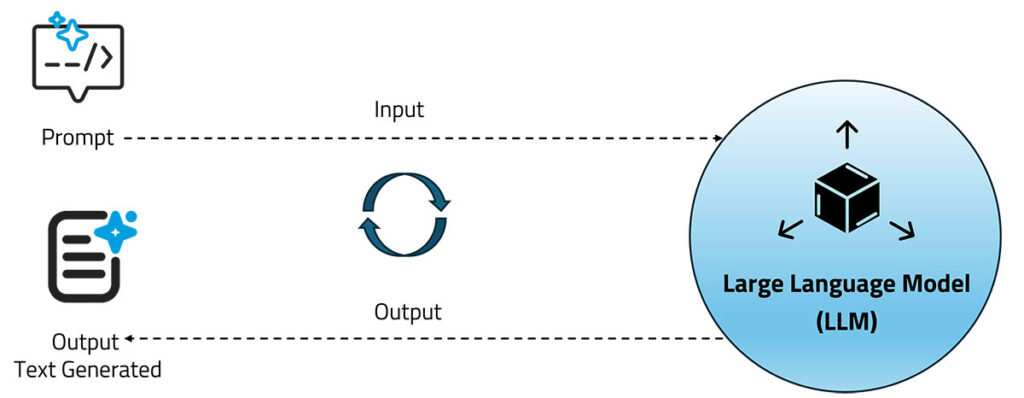In the world of artificial intelligence, one of the most powerful yet underrated skills are prompt engineering. It plays a crucial role in guiding AI models like ChatGPT to generate meaningful, relevant, and accurate responses.
Whether you’re a developer, content creator, or AI enthusiast, understanding prompt engineering can help you get the best out of AI systems. This guide will introduce you to the basics of AI prompt engineering and how to use it effectively.
What is Prompt?
A prompt is a natural language input that helps AI perform specific tasks smoothly. In generative AI, prompts create personalized content like conversations, images, and videos. They also assist in completing sentences, translating languages, summarizing documents, and answering questions.
The quality of AI-generated content depends on how clear and well-structured the prompt is. When creating AI prompts, consider these key factors:
Specificity – A clear and precise prompt guides AI to produce accurate and relevant responses. Vague prompts may lead to poor results.
Relevance – The prompt should match the subject, theme, and context of the desired output.
Tone & Style – Define the tone or style, such as formal, casual, academic, or humorous, to match the intended audience.
Length – The length of a prompt depends on task complexity. It can be a short phrase or a detailed paragraph.
What is AI Prompt Engineering?
AI prompt engineering is the process of crafting input instructions or questions in a way that optimally guides an AI model’s response. Since AI models rely on the context provided in the prompt, a well-structured prompt can significantly impact on the output quality.

For example:
Basic Prompt: “Explain machine learning.”
Optimized Prompt: “Explain machine learning in simple terms with examples of real-world applications.”
The second prompt provides more context, leading to a clearer and more useful response.
Why is Prompt Engineering Important?
AI models, such as GPT-based models, do not inherently “think” but generate responses based on the input they receive. A poorly framed prompt may result in vague or incorrect answers, while a well-crafted prompt can:
- Improve accuracy and relevance
- Reduce ambiguity
- Save time by reducing back-and-forth clarifications
Enhance creative and structured outputs
Best Practices for Effective Prompt Engineering
- Be Clear and Specific
Avoid vague prompts and be precise about what you want. Instead of asking, “Tell me about AI,” specify the scope, such as “What are the applications of AI in healthcare?”
- Provide Context
Adding background information helps AI generate more meaningful responses. For example, “Explain blockchain technology to a beginner with a focus on security features.”
- Define Output Format
If you need a structured response, specify it in your prompt.
For instance:
- “List five key benefits of AI in bullet points.”
- “Generate a three-paragraph summary on the impact of AI in business.”
- Use Examples
Providing examples within the prompt helps AI understand the desired format.
Example:
- “Write a short social media post about AI and productivity. Example: ‘AI is transforming workplaces by automating repetitive tasks, boosting efficiency, and allowing humans to focus on creativity. #AI #Productivity'”
- Experiment and Iterate
If the response isn’t as expected, tweak your prompt by making it more detailed or breaking it into multiple steps. Experimenting with variations helps refine the output.
Key Concept of Prompt Engineering
Prompt engineering helps AI models generate accurate and meaningful responses by optimizing input. Understanding its core concepts is essential for better interaction with AI. Here are five key concepts:

Prompt – A prompt is the input or instruction given to an AI model to generate a response. It can be a question, statement, or command guiding the AI’s output.
Context – Context provides background information in a prompt, helping AI understand the request better. More context leads to more accurate, relevant, and meaningful responses tailored to specific needs.
Token – AI processes text in small pieces called tokens. Words, phrases, and even punctuation marks are broken into tokens, affecting how AI understands and generates responses within a given limit.
Fine-Tuning – Fine-tuning adjusts an AI model by training it on specific data to improve accuracy. It helps customize AI for specialized tasks like legal analysis, medical advice, or customer support.
Priming – Priming involves setting AI’s expectations by giving examples or instructions before the main prompt. This helps guide responses toward a desired style, tone, or level of detail.
Types of AI Prompt Engineering Techniques
AI prompt engineering involves crafting prompts that guide AI models to generate specific outputs. Here are some common techniques:
Zero-shot prompting:
This technique involves asking the model to perform a task without providing examples. It’s useful for tasks where the model is expected to generalize its knowledge based on its training data.
Few shots prompting:
This method provides a few examples within the prompt to guide the AI. It’s beneficial when the model requires context or pattern recognition but does not need to be trained explicitly.
Chain-of-thought prompting:
In this technique, the prompt includes intermediate reasoning steps, guiding the model through a process. It’s commonly used for complex tasks requiring multi-step logic.
Instructional prompting:
Here, prompts are designed with clear and direct instructions for the model. This helps in fine-tuning the model’s focus on specific tasks, such as summarization, translation, or question answering.
Contextual prompting:
This method provides context or background information within the prompt, which helps the model understand the task more deeply. It’s useful when dealing with ambiguous queries.
Role-playing prompts:
The AI is assigned a role (e.g., as a teacher, assistant, or expert) to influence its tone, style, and depth of the response. This can guide the model toward producing more human-like responses based on predefined persona.
Prompt tuning:
A more advanced technique where the prompt itself is fine-tuned or adjusted over time to optimize the output based on specific needs, data, or user feedback.
Negative prompting:
This involves telling the model what to avoid or what’s undesirable in the response, helping to refine its output by constraining certain aspects.
Where are AI Prompt Engineering Solutions Used?
AI prompt engineering has diverse applications, and it’s used in diverse industry domains. Popular domains and areas where prompt engineering is used include:
Content Creation:
AI Prompt engineering solutions play a significant role in content creation. By crafting accurate prompts, modern businesses can easily generate highly relevant and engaging content for target audiences. Apart from that, marketing teams also use artificial intelligence to generate descriptions, and social media posts, and draft compelling copies that perfectly resonate with their potential customers.
Education & E-learning:
AI prompt engineering effectively enhances the process of tutoring system development. It improves personalized learning experiences and effectively streamlines student queries. Moreover, educators and trainers also leverage AI-generated prompts to develop dynamic and interactive content for several online courses. This makes online learning more engaging and interactive.
Customer Support:
AI-powered chatbots and virtual assistants use smart prompts to answer customer questions accurately, reducing response time and improving satisfaction by providing helpful, clear, and relevant solutions without needing human intervention.
Healthcare Assistance:
In the healthcare domain, AI prompt engineering helps in data analysis and medical research. Researchers leverage artificial intelligence to analyze large datasets and generate insights. This leads to advanced treatment and diagnosis. Healthcare experts also benefit from AI prompts for additional guidance and information on complex medical scenarios.
Business Analytics:
AI-powered reports and data insights help businesses make smarter decisions by analyzing trends, generating forecasts, and answering specific business questions accurately, all driven by well-structured prompt engineering techniques.
Software Development:
Developers use AI-assisted coding tools that generate code snippets, debug errors, and suggest optimizations through precise prompts, making software development faster, more efficient, and accessible to both beginners and experts.
What is The Future of AI Prompt Engineering?
The future of AI prompt engineering will focus on making AI more intuitive, efficient, and accessible across industries. Here are some key trends:
Automated Prompt Optimization – AI will self-improve its responses by learning from interactions, reducing the need for manual prompt refinement.
Multimodal Prompting – Future AI models will understand and generate responses from a mix of text, images, audio, and video prompts, making interactions richer.
Personalized AI Assistants – Advanced prompt engineering will enable AI to remember user preferences, delivering highly customized responses based on past interactions.
Low-Code/No-Code AI Interactions – AI tools will allow users to create applications, automate workflows, and generate reports using simple, natural-language prompts.
Ethical & Bias-Free AI – Enhanced prompt strategies will help minimize biases in AI responses, ensuring fairness, accuracy, and inclusivity in different applications.
AI-Driven Research & Creativity – Future AI models will generate deeper insights, innovative ideas, and creative solutions, revolutionizing fields like science, design, and entertainment.
Conclusion
AI prompt engineering is a valuable skill that can enhance how you interact with AI models. By crafting precise, structured, and well-contextualized prompts, you can unlock the full potential of AI-powered tools. Whether you’re using AI for writing, coding, or analysis, mastering prompt engineering will help you get better, more accurate results.
Are you ready to refine your AI interactions? Start experimenting with different prompts today and see how small changes can make a big difference!
FAQs
What is prompt engineering?
Prompt engineering is the process of creating clear and specific input to guide AI models in generating desired outputs.
Why are clear prompts important?
Clear prompts help AI understand the task, leading to more accurate, relevant, and efficient responses, saving time and resources.
How do I create effective AI prompts?
Effective prompts should be specific, relevant, and provide context or examples to guide the AI towards the desired output.
What are the common techniques in prompt engineering?
Common techniques include zero-shot, few-shot, chain-of-thought, and instructional prompting, each helping refine AI-generated results in various tasks.

Abhishek Sharma
Website Developer and SEO Specialist
Abhishek Sharma is a skilled Website Developer, UI Developer, and SEO Specialist, proficient in managing, designing, and developing websites. He excels in creating visually appealing, user-friendly interfaces while optimizing websites for superior search engine performance and online visibility.

